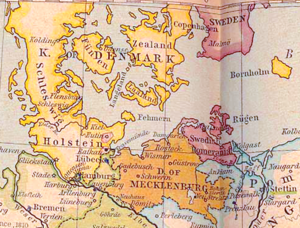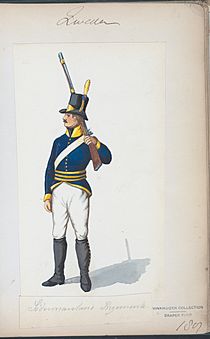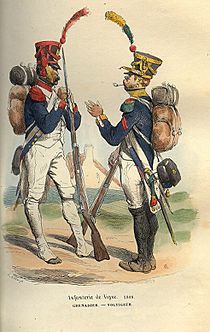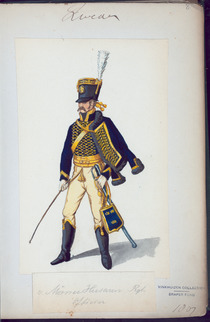Great Sortie of Stralsund facts for kids
Quick facts for kids Great Sortie of Stralsund |
|||||||
|---|---|---|---|---|---|---|---|
| Part of the Franco-Swedish War and the War of the Fourth Coalition | |||||||
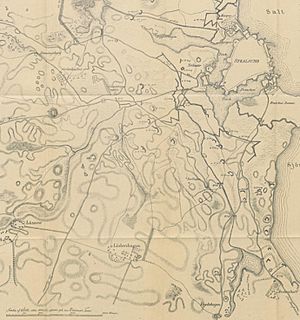 Stralsund and nearabouts (Lüssow, Lüdershagen and Voigdehagen; bottom), by O.W. Smith |
|||||||
|
|||||||
| Belligerents | |||||||
| Commanders and leaders | |||||||
| Strength | |||||||
| 5,000–6,000 | 5,700 | ||||||
| Casualties and losses | |||||||
| 1,300 killed, wounded or captured | 100 killed or wounded | ||||||
The Great Sortie of Stralsund was a battle fought from April 1 to 3, 1807. It took place in Swedish Pomerania, which is now part of Germany. This battle was part of the larger Franco-Swedish War and the War of the Fourth Coalition.
A "sortie" means a sudden attack made by soldiers from a place that is being surrounded. In this case, Swedish forces broke out from the town of Stralsund. They aimed to push out the French army that was blocking the town. The Swedes won this battle, forcing the French to leave Swedish Pomerania.
Contents
Background to the Conflict
The Napoleonic Wars were a series of major conflicts in Europe. They involved the First French Empire, led by Napoleon Bonaparte, and many other European powers. Sweden, led by King Gustav IV Adolf, joined the war against France in 1805. The king strongly disliked Napoleon.
At first, the war was not going well for Sweden and its allies. In late 1806, French forces invaded Swedish Pomerania. They began to block the important Swedish town of Stralsund. The French army, led by General Édouard Mortier, had about 12,000 soldiers.
The Swedes had about 13,000 soldiers in Stralsund and on the nearby island of Rügen. After some smaller fights, many French soldiers were sent to help with another battle. This left a smaller French force of 5,000–6,000 men under General Charles Louis Dieudonné Grandjean.
The Swedish commander, General Hans Henric von Essen, saw an opportunity. He decided to plan a large attack, or "sortie," to drive the French away. General Grandjean even asked for a ceasefire, hoping to leave without looking like he was forced out. But General Essen refused.
The Battles Unfold
On March 31, General Essen prepared his Swedish army for the big attack. He divided his forces into two main groups, called columns. The right column, with about 2,500 men, was led by General Johan Henrik Tawast. General Essen himself was with this group.
The left column, with about 2,300 men, was led by General Eberhard von Vegesack. General Gustaf Mauritz Armfelt was in charge of this column. There was also a reserve force of 900 men left inside Stralsund.
Fighting on April 1: Lüdershagen and Voigdehagen
The Swedish attack began on April 1. The right column moved out at 7:00 AM. They quickly took a French fort that had been left empty. They captured several other places, including a French supply depot.
Meanwhile, the left column started its march at 8:00 AM. They pushed the French out of several positions. The two Swedish columns then met up at Langendorf.
Next, the Swedes attacked Lüssow. A few hundred French soldiers defended it bravely. The Swedes attacked from the front and sides, using their cannons. The French were eventually forced to retreat to Lüdershagen.
At Lüdershagen, the French had strong defenses and more soldiers. They fought back hard, and several Swedish attacks were stopped. But when more Swedish soldiers arrived, they stormed the village together. The French had to pull back again.
The French then made a stand on the high ground at Voigdehagen. Another fierce battle took place there, lasting for about an hour.
A small Swedish group tried to cut off the French retreat near Wendorf. But they met strong French forces with cannons. The French fired so intensely that the Swedish infantry had to lie down. Swedish cannons then cleared the forest.
The Swedish group attacked the French cannons. This, along with the attacks from the north, forced the French to leave Voigdehagen.
At the same time, the Swedish reserve force fought on the French right side. They pushed back a French cavalry attack. They also captured two fortified places, where the French lost many soldiers. After hours of fighting, the tired Swedish soldiers rested for the night. The main French army had retreated to Greifswald.
Taking Greifswald on April 2
The next morning, the Swedish columns continued chasing the French army. General Tawast's column marched towards Loitz. General Armfelt split his force into two groups. One group marched directly towards Greifswald. The other group tried to get behind the retreating French.
When a Swedish messenger approached Greifswald to ask for its surrender, the French soldiers panicked and ran. A few Swedish cavalrymen chased them into the town and captured several prisoners.
The French soon regrouped outside the town and attacked back. General Armfelt himself almost got captured. But as more Swedish troops arrived, the French were pushed back again. Swedish gunboats also attacked a village near Greifswald, destroying a small fort there. The Swedes spent the night in Greifswald.
Final Push on April 3: Demmin and Anklam
On April 3, General Tawast's column continued its march. Their goal was to capture the French baggage train near Demmin. When the Swedish cavalry arrived, they charged through the open gates into the town. They captured 129 French soldiers.
The French forces retreated towards Mecklenburg. Swedish cavalry chased them, capturing many more prisoners and valuable supplies along the way. For example, 42 Swedish cavalrymen captured a French baggage train and 209 soldiers.
Meanwhile, General Armfelt's columns also continued their advance. One column marched towards Anklam. When they arrived, Swedish soldiers attacked the town's outer areas. After an hour of fighting, they forced the French to retreat across the Peene river into Anklam itself. The French had destroyed the bridge, making it hard for the Swedes to cross.
After some time, a small group of 50 Swedes crossed the river in a small boat. They launched a surprise bayonet charge, forcing the French away from the bridge. More Swedes crossed and joined the fight. The French quickly ran away, leaving their supplies and 167 soldiers behind.
By this point, Swedish Pomerania was clear of French troops. The remaining French forces retreated to Stettin.
Aftermath of the Sortie
The Swedish victory came with very few losses for them. General Armfelt's column lost only 15 killed and 33 wounded. The French losses were much higher. The Swedes captured at least 1,000 French soldiers, possibly up to 1,800. The Swedes also captured a lot of valuable equipment and supplies.
News of the Swedish victory caused excitement in Sweden. It also worried the French army, especially in Berlin. The Swedish offensive continued for a few more days. They captured Rostock, Ueckermünde, and Schwerin. They also took the island of Wolin.
However, the Swedish army had spread out too much. On April 16, a large French army of 13,000 men, led by General Mortier, returned. They defeated the Swedish left flank. The Swedes had to retreat back to Swedish Pomerania.
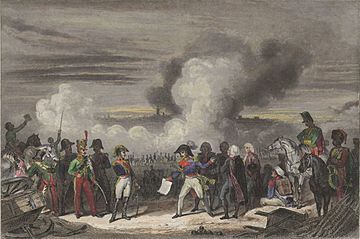
An agreement to stop fighting, called an armistice, was signed on April 18. This meant all Swedish troops pulled back into Swedish Pomerania. But the Swedish king ended the armistice on July 3. By this time, Sweden had lost most of its allies.
On July 13, a new French army of 40,000–50,000 men invaded again. They began a siege of Stralsund. The town was captured on August 20, and the Swedes moved to the island of Rügen. By September 7, all of Swedish Pomerania was under French control.
The war between Sweden and France continued until January 6, 1810. Sweden was eventually forced to sign a peace treaty.


